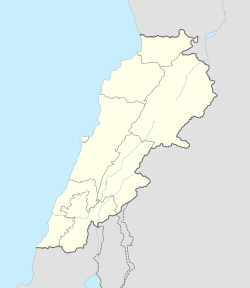Top Qs
Timeline
Chat
Perspective
Kfar Kila, Lebanon
Municipality in Nabatieh Governorate, Lebanon From Wikipedia, the free encyclopedia
Remove ads
Kfar Kila or Kfarkila (Arabic: كفركلا, also, Kfarkila, Kfarkela, Kafarkela) is a municipality in Southern Lebanon. The majority of its population are Shia Muslims.[1]
Remove ads
Etymology
The name Kafarkila means "the village of the pasturage".[2]
History
Summarize
Perspective
Al-Maqdisi (c. 945/946 – 991) noted that Kafr Kila (called Kafar Kila) was "A place lying a day's march from Tabariyyah".[3]
Ottoman era
In the 1596 tax records, it was named as a village, Kafr Kuk, in the Ottoman nahiya (subdistrict) of Tibnin, part of Safad Sanjak, with a population of 31 households and 2 bachelors, all Muslim. The villagers paid taxes on agricultural products, such as wheat, barley, olive trees, goats, beehives and winter pastures; a total of 4,700 akçe.[4][5]
In 1838, Eli Smith noted Kafr Kila's population as Metawileh.[6]
In 1875 Victor Guérin visited and noted that the village had about 1,000 Metawileh inhabitants.[7] He further noted: "The mosque and several of the houses are built of old materials. The spring is partly ancient."[8]
In 1881, the PEF's Survey of Western Palestine (SWP) described it as "a village, built of stone and mud, containing about 150 Moslems, situated on sloping ground, with figs, olives, and arable land around. A good spring near."[9]
Modern era
The total population of the village is about 14,500[citation needed]. The occupants' number increases dramatically during summer. Its altitude is around 700 m from sea level.[10]
Many developments are currently taking place due to the efforts and the determination of the municipality side by side with the people in order to mitigate the problems that accumulated over the years from central government indifference, civil war, occupation and border wars.
Following the 1982 Israeli invasion Kafr Kila became part of the Israeli security zone. On 11 September 1989 three IDF soldiers were wounded in an ambush in Kafr Kila. The Lebanese Communist Party claimed responsibility. Two of the attackers were killed.[11]
Hezbollah's participation in the Gaza war, backing Hamas and attacking Israel, escalated the border zone into an active war zone characterized by frequent cross-border attacks. As a result, almost all the village's residents have left.[1]
On October 1, 2024, the IDF claimed that since the onset of the Israel–Hezbollah conflict in October 2023 and leading up to the October 2024 ground operation, it has destroyed 158 Hezbollah targets in Kfar Kila, including 28 lookout posts and an array of weapons.[12] As of October 25th almost the entire southern part of the village has been destroyed during the 2024 Kfar Kila clashes
Remove ads
Demographics
As of 2010, the village had 7,000 year round residents and its population rose to 9,000 during the summer months. At least 2,500 villagers had been displaced to other parts of Lebanon by the 2006 Lebanon War and another 500 had migrated abroad.[13]
In 2014 Muslims made up 99.56% of registered voters in Kfar Kila. 97.41% of the voters were Shiite Muslims.[14]
References
Bibliography
External links
Wikiwand - on
Seamless Wikipedia browsing. On steroids.
Remove ads


